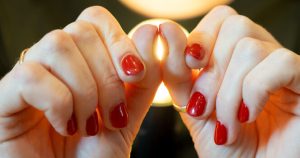According to physicians, a straightforward test that involves creating a tiny diamond window with your fingers can help you spot the early warning symptoms of major illnesses including heart disease and lung cancer.
Imagine having the ability to quickly conduct a test with your own hands that may provide you with an early indicator of a dangerous medical problem.

Medical specialists have identified the Schamroth window test, a straightforward and non-invasive finger check, as a possible sign of finger clubbing, a condition associated with heart disease, lung cancer, and other dangerous illnesses.
Let’s explore the Schamroth’s operation and potential health implications.
Clubbing with the fingers
According to Medscape, finger clubbing, often referred to as digital clubbing, is a condition that alters the form of the fingers and fingernails. The Schamroth window test is a straightforward method for detecting this problem.
Finger clubbing usually occurs in phases and takes years to develop. Cancer Research UK states that in the event that finger clubbing occurs:
The skin surrounding the nail seems glossy, and the nail bed feels warm.
The fingers appear “clubbed” because their ends appear larger.
The nail bed is becoming softer.
The nails have a greater curvature; they resemble spoons and curl downward.
It feels like spongy nail beds.
According to Very Well Health, finger clubbing is thought to “occur because of long-term low levels of oxygen in the blood, known as hypoxemia,” however the precise cause is yet unknown.
Possible circumstances
A number of significant conditions have been linked to finger clubbing, including:
Lung cancer: Research indicates that finger clubbing occurs in 35% of patients with non-small cell lung cancer and is less frequent (about 4% of small cell lung cancer cases).
Mesothelioma: This uncommon cancer affects the lining of the chest and lungs and is frequently brought on by asbestos exposure. Numerous mesothelioma patients have been reported to exhibit finger clubbing.
Chronic lung illnesses: Long-term oxygen deprivation from diseases such asbestosis, bronchiectasis, pulmonary fibrosis, and cystic fibrosis can cause finger clubbing.
Heart conditions: Infectious endocarditis, an infection of the heart’s lining, and some congenital heart problems can cause inadequate oxygen circulation, which can lead to clubbing.
Liver and gastrointestinal disorders: Digital clubbing has been linked to conditions like cirrhosis, Crohn’s disease, and inflammatory bowel disease (IBD).
Homemade test
To administer the test, take the following actions:
Your hands should be in front of your eyes.
Touch the fingernails together by pressing your index fingers together.
Pay attention to the distance between the nails.
The nail beds should normally be separated by a tiny, diamond-shaped space. Absence of this gap may indicate finger clubbing, which would require additional medical assessment.
“Your fingers are clubbed if there is no gap visible under your nail beds. You should see your general practitioner right away so they can determine whether the clubbing is due to an underlying condition,” oncology nurse Emma Norton told the Huffington Post.
Please keep in mind that the results are merely a caution to seek medical assistance and do not provide a conclusive diagnosis.
Don’t freak out if you see changes in your nails or fingers, but don’t ignore them either! Treating underlying issues can be greatly impacted by early discovery.
Did you realize how much could be revealed by such a basic test? Kindly let us know what you think, and then tell your friends about this story so they may also check for finger clubbing!
